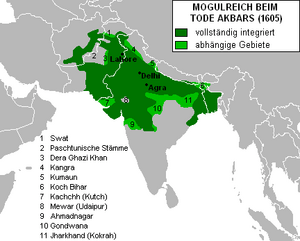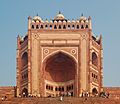Mughal Empire facts for kids
The Mughal Empire (pronounced Moo-gahl) was a powerful empire in Asia that lasted for over 300 years, from 1526 to 1858. It was called an empire because it covered a huge area. At its largest, it ruled most of the Indian subcontinent, which was then known as Hindustan. This included parts of modern-day India, Afghanistan, Pakistan, and Bangladesh.
The Mughal Empire was one of the world's biggest economies. It was known for its early steps towards industrial growth and its amazing, fancy buildings. The Mughal emperors were originally from a group called Turk-Mongols.
Contents
Founding the Empire
The Mughal Empire was started by Babur in 1526. He was from the Timurid dynasty. Babur ruled until 1530. He was a skilled warrior and a great leader.
Important Rulers
After Babur, several powerful emperors ruled the Mughal Empire:
- Humayun (1530-1540 and 1555-1556)
- Akbar (1556-1605) - He was known as "Akbar the Great" because he made the empire very strong and united.
- Jahangir (1605-1627)
- Shah Jahan (1628-1658) - He is famous for building the Taj Mahal.
- Aurangzeb (1658-1707)
After Aurangzeb's death, the empire started to become weaker. It continued to exist with smaller rulers until 1857-1858. By this time, much of India came under the control of the British Raj.
Mughal Achievements
The Mughal rulers were very good at uniting different parts of India. They brought many areas under one strong government.
Art and Architecture
During the Mughal period, art and architecture really grew and became famous. Many beautiful buildings and monuments were constructed. The rulers loved art and were also great warriors.
The Mughals left a lasting mark on India's society, culture, art, and buildings. Their monuments, artworks, and writings show a time of great wealth and creativity. For example, miniature paintings from that time teach us about the clothes and daily life of people.
Images for kids
-
Akbar holds a religious assembly of different faiths in the Ibadat Khana in Fatehpur Sikri.
-
Group portrait of Mughal rulers, from Babur to Aurangzeb, with the Mughal ancestor Timur seated in the middle. On the left: Shah Jahan, Akbar and Babur, with Abu Sa'id of Samarkand and Timur's son, Miran Shah. On the right: Aurangzeb, Jahangir and Humayun, and two of Timur's other offspring Umar Shaykh and Muhammad Sultan. Created c. 1707–12
-
Ruins of the Great Caravanserai in Dhaka.
-
Badshahi Mosque, Lahore, Punjab, Pakistan
See also
 In Spanish: Imperio mogol para niños
In Spanish: Imperio mogol para niños




















